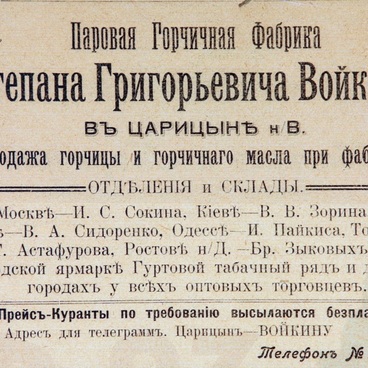The collection of the Volgograd Regional Museum of Local History contains several dozens of tile fragments. One of the unique exhibits is a fragment of a glazed tile with Arabic letters.
The Golden Horde cities of the Volga region adopted the Central Asian traditions of town planning. Under the influence of Central Asian art, such settlements developed their own traditions of external building decoration. Ceramic tiles as elements of architectural decoration were widespread in the Golden Horde.
In those days, one of the types of ceramics produced was polychrome majolica — glazed tiles made from colored fired clay with a coarse porous ceramic body. This tile was made using precisely this technique. Glaze was a thin layer of vitreous coating that was applied to the surface of the ceramic piece.
Polychrome tiles were true works of art. Public buildings — mosques, madrasahs, mausoleums, palaces of khans and nobles — were richly decorated with them. Various shades of navy blue and blue, as well as white, were considered the most typical colors.
Glazes without lead oxide were mainly used in decorating the buildings in the Golden Horde, which gave them greater weather resistance. A translucent glaze required the use of a light base of red clay and kashi, the latter being made by combining fine quartz sand, white clay and lime, followed by firing at temperatures of 1,000–1,200°C.
The tile from the museum’s collection has a fragment of an Arabic inscription on it. It testifies to the fact that the Golden Horde was Islamized in the 14th century during the reign of Khan Uzbek (1313-1342). Historians have discovered that the item in question was made by captives.
Traditionally, inscriptions in Arabic ceramic tiles made up passages from the Quran and oriental poetry. Such sacred and solemn inscriptions were executed in calligraphic Kufic script. The plant motifs that have survived on ceramic tiles are related to Islamic symbolism.
The Golden Horde cities of the Volga region adopted the Central Asian traditions of town planning. Under the influence of Central Asian art, such settlements developed their own traditions of external building decoration. Ceramic tiles as elements of architectural decoration were widespread in the Golden Horde.
In those days, one of the types of ceramics produced was polychrome majolica — glazed tiles made from colored fired clay with a coarse porous ceramic body. This tile was made using precisely this technique. Glaze was a thin layer of vitreous coating that was applied to the surface of the ceramic piece.
Polychrome tiles were true works of art. Public buildings — mosques, madrasahs, mausoleums, palaces of khans and nobles — were richly decorated with them. Various shades of navy blue and blue, as well as white, were considered the most typical colors.
Glazes without lead oxide were mainly used in decorating the buildings in the Golden Horde, which gave them greater weather resistance. A translucent glaze required the use of a light base of red clay and kashi, the latter being made by combining fine quartz sand, white clay and lime, followed by firing at temperatures of 1,000–1,200°C.
The tile from the museum’s collection has a fragment of an Arabic inscription on it. It testifies to the fact that the Golden Horde was Islamized in the 14th century during the reign of Khan Uzbek (1313-1342). Historians have discovered that the item in question was made by captives.
Traditionally, inscriptions in Arabic ceramic tiles made up passages from the Quran and oriental poetry. Such sacred and solemn inscriptions were executed in calligraphic Kufic script. The plant motifs that have survived on ceramic tiles are related to Islamic symbolism.



